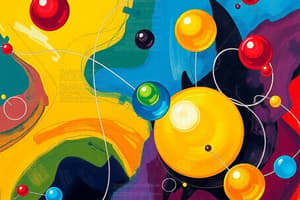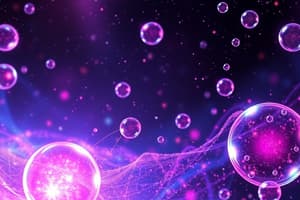Podcast
Questions and Answers
What does the atomic number of an atom represent?
What does the atomic number of an atom represent?
- The number of neutrons in the nucleus
- The total number of particles in the atom
- The number of protons in the nucleus (correct)
- The number of electrons in the atom
How many electrons does a neutral atom have?
How many electrons does a neutral atom have?
- Twice the number of protons
- Less than protons
- More protons than neutrons
- The same number as protons (correct)
Which particle is not found in the nucleus of an atom?
Which particle is not found in the nucleus of an atom?
- Electron (correct)
- All are found in the nucleus
- Proton
- Neutron
What is the smallest unit of matter that retains the properties of an element?
What is the smallest unit of matter that retains the properties of an element?
What particles make up an atom?
What particles make up an atom?
Flashcards are hidden until you start studying
Study Notes
Structure of Atoms
- Atoms represent the fundamental building blocks of matter.
- Composed of three primary subatomic particles: protons, electrons, and neutrons.
Protons
- Protons are positively charged particles found in the nucleus of an atom.
- The atomic number is defined by the number of protons present in the nucleus, determining the element's identity.
Electrons
- Electrons are negatively charged particles that orbit the nucleus of an atom.
- In a neutrally charged atom, the number of electrons equals the number of protons, balancing the overall charge.
Neutrons
- Neutrons are neutral particles found in the nucleus alongside protons.
- The number of neutrons can vary within atoms of the same element, leading to different isotopes.
Studying That Suits You
Use AI to generate personalized quizzes and flashcards to suit your learning preferences.




